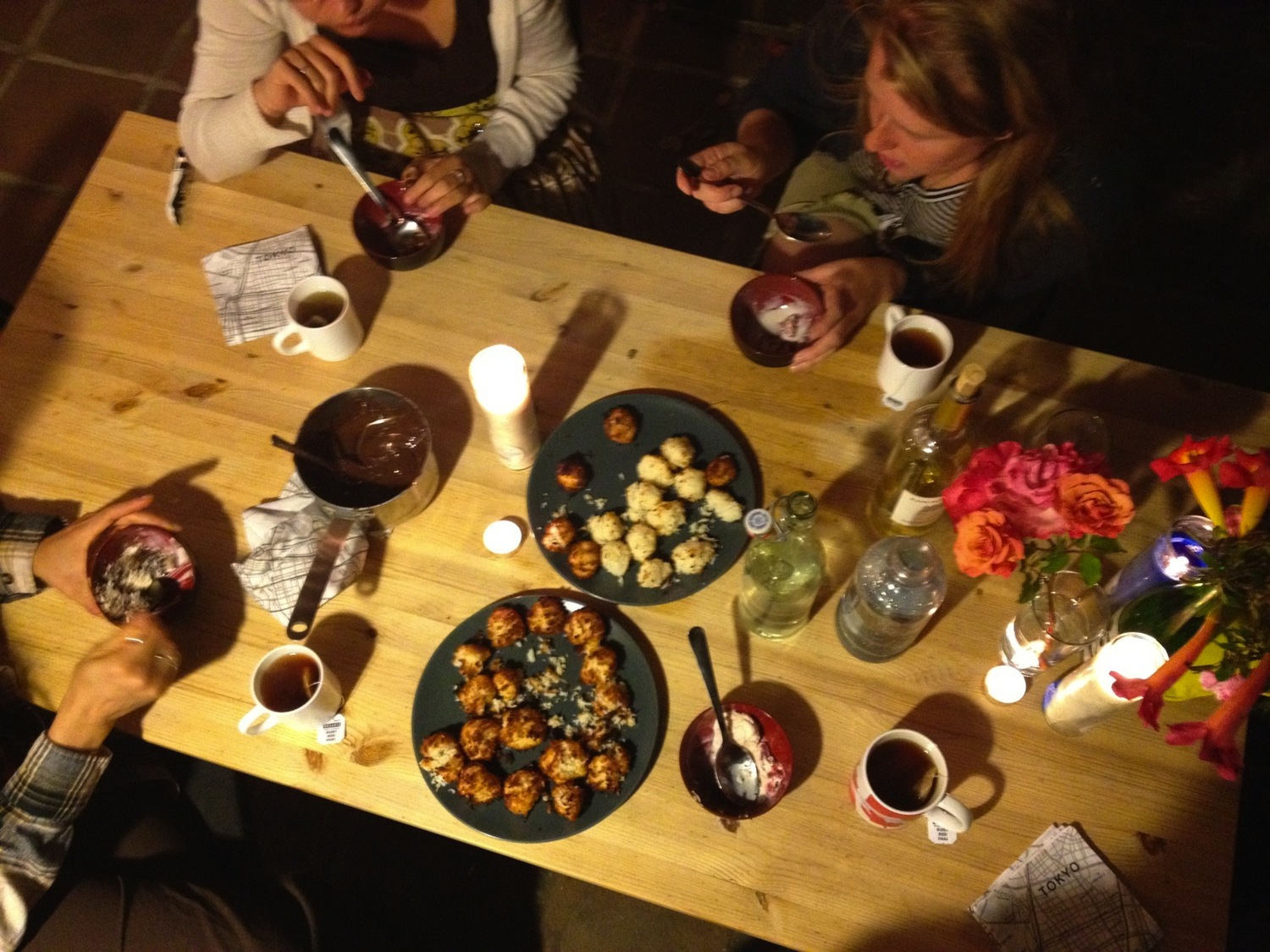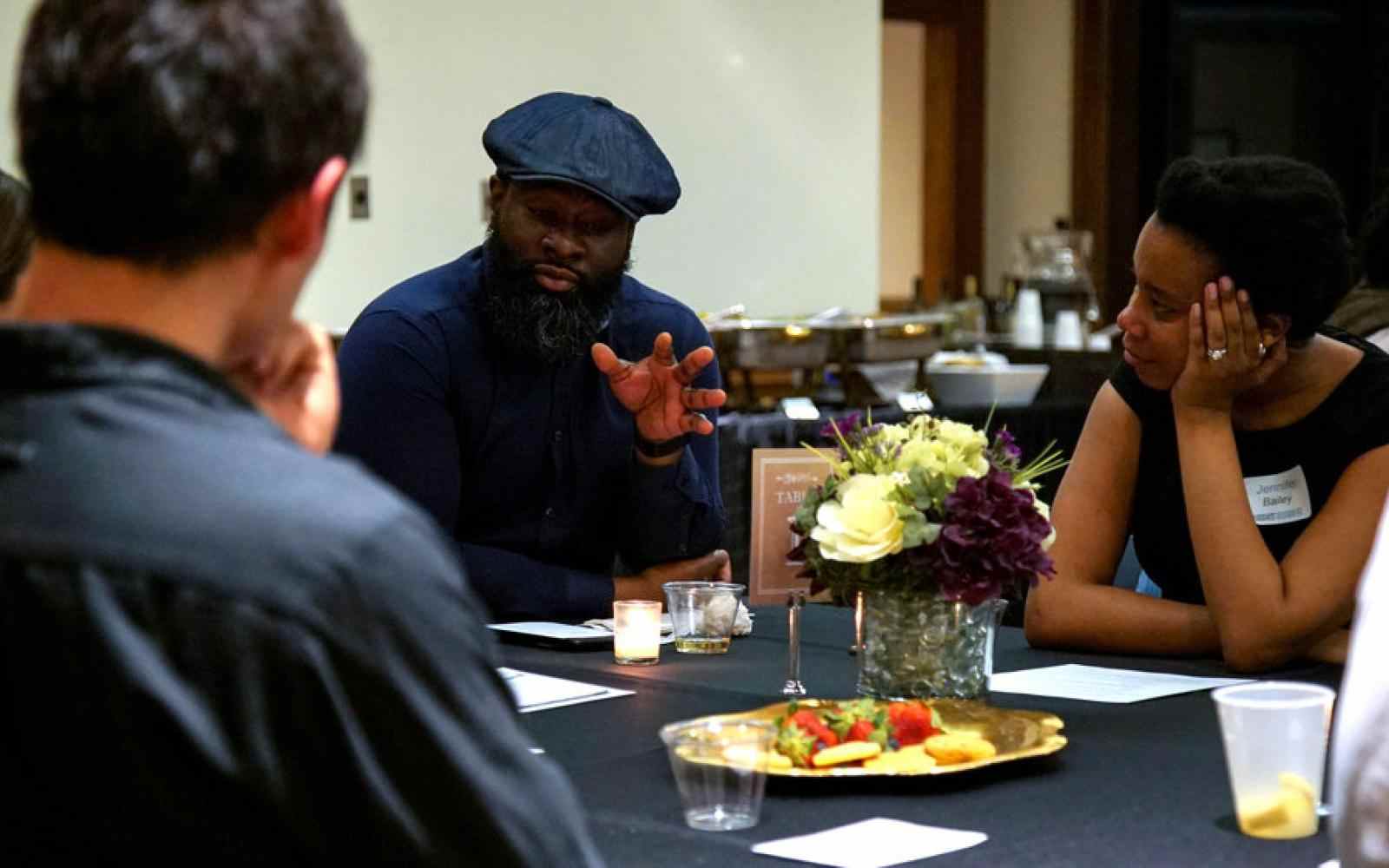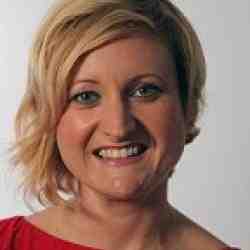The world feels more fractious with every passing day. People who are different from each other, or who hold different points of view, struggle to bridge differences.
Since January 2017, The People’s Supper project has been tackling this disconnect head on by inviting people, who often have never met, to sit at the same table and share their stories. At more than 200 dinner tables across the United States, people break out of their echo chambers and stop seeing each other as monoliths: one-sided stereotypes that can be reduced to a single word or phrase.
Instead, they come to see each other has rich, complex humans, according to Ashoka Fellow Lennon Flowers, co-founder and executive director of The Dinner Party, one of the three organizations that have collaborated to create The People’s Supper.
Lennon Flowers
Ashoka Fellow since May 2016
Lennon combined forces to create The Dinner Party with two other Ashoka Fellows Emily May (co-founder of Hollaback!, working to end sexual, gender-based, and prejudiced-motivated harassment online and in public spaces), and Jennifer Bailey (founder of Faith Matters Network, a people of color-led collective equipping faith leaders with tools to build healthy, equitable communities) to build bridges to make the shift from a place “where people began to assume the worst rather than the best of one another.”
“This isn’t about a political party, or what is or isn’t happening in Washington,” Lennon said. “Rather, it was borne out of post-election ruptures at the family Thanksgiving table, and in communities where people began to assume the worst rather than the best in one other."
“We Need a Way to Talk Openly”
The People's Supper started as an experiment: the goal was to get people to sit down at 100 dinners during the first 100 days of the new presidential administration in Washington, D.C. “It seemed impossible, but we ended up doing 140 dinners,” Lennon said. “Since then, we’ve hosted over 200 dinners across the country. Due to demand and interest, we’re keeping the conversation going over the next year, at least.”
“Lacking relationships across lines of difference, we reduce each other to caricatures and are led to believe our worst stereotypes," Lennon said. "Correcting that, we realized, could not be done with op-eds, or with arguments. We needed a way to talk openly about the kinds of experiences all of us share: the stories of grief and vulnerability and heartache — and joy and hope, too — that change the way we see ourselves and one another.”
The People’s Supper “is designed to get people to sit down with one another across political views, across identities, and fully see and hear one another – to believe in and to see each other’s humanity,” adds Emily May.
Lennon brought her four years of experience developing a network of dinner parties that create a space for people who are grieving over a loss. These dinners are a way to connect with others to share experiences of grief in a natural and comfortable way while building a community of friends.
It Started with a Late Night Conversation About Grief
Lennon’s mother was diagnosed with cancer when Lennon was a high school senior and she died of stage four cancer when Lennon was finishing her last year of college. Lennon had moved from the East Coast to Los Angeles and found “I had no vocabulary to talk about my mom, the life she lived, how it influenced the person I became, and how her absence complicated my family story. I didn’t know how to bring it into a conversation without scaring off new friends.”
Things changed when her friend Carla Fernandez told her over coffee that her that her father had passed away six months before. Lennon did not mention her mother at time, not wanting to make Fernandez “uncomfortable with my life.” But then Fernandez invited Lennon for dinner one night and they talked until 2 a.m.
It was the first Dinner Party. “What we found in that kind of space was that we could be in a community where you didn’t have to hide – you didn’t have to make a part of your life or story off-limits, or feel cagey about sharing. As relationships grew, it didn’t mean we talked about grief and loss specifically every time or in every moment. But you could talk about times when it was triggered by something, or you just happened to be having a hard day,” Lennon said.

“It became a vehicle for processing all of that in a way that didn't feel embarrassing. It was simple but beautiful. It’s about turning loss from a conversation-killer into a conversation-starter and taking what are otherwise isolating experiences and turning them into profound sources of empathy and connectivity.
“Through, intimate, peer-driven dinner parties, we work to turn our most isolating experiences into sources of rich community, empathy, and meaningful conversation. As cagey and self-conscious as we are about those stories, when we share, it is an invitation to others to share theirs.”
Figuring It Out: What is a Dinner Party?
Lennon used money she received from her mother’s life insurance to pay her rent and “dove in,” launching an Indigogo campaign to raise funds for initial Dinner Party trainings and staff retreats. By co-founding The Dinner Party with Fernandez, they found a way “to replicate the experience we had had around that first table, without our having to be in the room or resorting to formulaic conversation, or the same institutional feel that compelled us to create The Dinner Party in the first place.”
What had begun as a casual gathering of friends became a quest to reimagine and reinvent "grief support," and the very way we conceive of and talk about loss.
The Dinner Party has grown from a couple of dozen people at the end of 2013 to 600 dinner parties in 114 U.S. cities and more than 150 tables worldwide that has connected more than 4,000 one-time strangers to one another.
“Our first step was to figure out what a dinner party is: everything from tips and tricks to breaking the ice, to the essential ingredients of open, honest, bullshit-free conversation among peers," Lennon said. "We developed a Host Guidebook and made it immediately available for download, encouraging anyone to sit down with people they know and talk about things they normally don’t."
“The organic quality behind The Dinner Party and our evolution thus far has been key to our success,” Lennon adds. “It’s provided us with the agility to act quickly and a grassroots feel that is attractive to a generation wary of institutions and hypersensitive to authenticity. You would expect growth to produce a decline in quality, but we have witnessed the opposite: people believed more in the idea and were willing to invest more in it.”
Recently, The Dinner Party has been experimenting with an initiative to help workplace managers hold a place for employees who are grieving from a loss called The Dinner Party at Work. “In the immediate months following a loss, we are informed very profoundly — not just by how your community showed up or didn’t — but by how your workplace responded. The feedback we’ve consistently received is that loss, and life afterwards, is indeed deeply affects organizational culture and the bottom line, and that no one feels equipped to handle it.
“Nobody wants to be a terrible friend colleague or manager. The problem is an absence of knowing how to have these kind of conversations. We think we live in a grief-phobic society, but I don’t actually think that. It's just that with grief we are afraid of saying or doing the wrong thing, so we don’t say anything at all.”
It’s Not Solving for Grief – Isolation is the Key
As the dinner parties multiplied, Lennon began to see them “not exclusively as a vehicle for connecting around grief from death or loss, but for taking sources of struggle that are shared experiences and turning them into experiences of connectivity.
It didn’t take us long to realize that our work isn’t really about grief – the thing we were solving for wasn't grief, because you can't solve grief and you shouldn’t want to. It's not a thing to be fixed but to be held. The thing to fix is isolation – because of the way we silence ourselves: whatever you feel, you feel alone – you should be feeling or doing something else. It’s the rupturing of relationships that undergird every other problem in the world.”
“That’s where we can help stage an intervention and connect people around shared experiences – so we water the seeds of resilience that live inside everything.”
The Dinner Party became a way to do bridge building, not just across political differences but across lines of difference so that people might stop making assumptions based on a label or a stereotype that they placed on each other. “We were thinking about this for a long time, and then the elections happened,” Lennon said.”

In the wake of last year’s divisive presidential campaign, The Dinner Party began trying to create healing spaces “to combat the hostility that permeates our present politics” so “we could build real trust and meaningful connection across lines of difference, be they political, cultural, racial, religious, or generational.” Following the election people expressed a hunger for ways to restore connections and heal from the divisive political campaign, and this propelled the demand for The People’s Supper.
Self-Organizing to Meet a Growing Demand
The demand was met because three Ashoka Fellows came together and pooled their organizations’ networks to spread the word and organize the dinners. “We envision a future in which other organizations and peer networks comprised of people with a shared experience — veterans’ groups, organizations serving the formerly incarcerated and their families, or support networks for survivors of domestic violence or sexual assault — can launch their own tables.”
Lennon credits Ashoka and its network for having supported the three Ashoka Fellows that collaborated and built this movement: The Dinner Party, Hollaback, and the Faith Matters Network. These organizations “were borne of this network, and the way in which we are thinking was borne of this network,” she said." “From the outset, our end-goal was one of culture change.
“Ashoka has been everything for me — an extraordinary laboratory of the world's best ideas and extraordinary people. They were people who recognized their own agency and that their role in the world was to give other people that agency so they could claim their power to move the world. They combined this with a deeply sophisticated ability to understand and diagnose problems.”



